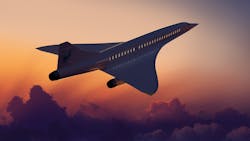The speed of air travel has always been the primary appeal. However, imagine readily available supersonic travel opportunities.
Boom Supersonic is in the process of creating the world’s fastest airliner. The goal? To cut long-distance flight time in half and revolutionize passenger air travel in the process. The company is preparing for the first flight of its one-third scale demonstrator aircraft, the XB-1, next year.
“Supersonic air travel will propel us towards the future of travel. While there is such exciting technology behind what we’re building, our pursuit of speed runs deeper—it’s about how humans experience each other and the planet,” says Mike Jagemann, director of XB-1 production at Boom Supersonic. “An airplane that flies twice as fast lets us all experience more of the world’s people, places, and cultures.”
Jagemann says the conditions for mainstream supersonic flight are all here. “International passenger travel has grown more than 7x since 1970 and despite the short-term effects of COVID-19, these trends are expected to continue,” he says. “Technological advancements allow Overture to fly sustainably on more than 500 transoceanic routes—at fares comparable to today’s business class. Leveraging scientific advancements in aerodynamics, materials, and propulsion, Overture will reduce operating costs enough to turn a profit at business-class fare levels that the market already supports.”
What makes Boom different?
Boom is not the first to set its sights on supersonic flight. And, unfortunately, earlier attempts at commercial supersonic flight were unable to achieve sustainability, economically or environmentally.
The last time paying passengers flew supersonic it was a government-driven Cold War-era prestige project involving a consortium of large, established aerospace companies joining together and spending more than ten years and an enormous amount of development resources and risk to make it happen. This time around, Boom, as a private company, is working within a business context, in order to ensure that the end product, Overture, can be profitable for its customers and the company itself. Fortunately, aircraft technology has advanced a lot in 50 years. Today’s aerodynamic design capability, material properties, and engine performance have mostly overcome the issues that grounded the last supersonic aircraft.
To bring it to life, Boom has embraced 3D printing (including a host of printers from Stratasys) in nearly every facet of the aircraft’s development. Boom has leveraged 3D printing to rapidly manufacture hundreds of printed parts, tools and prototypes, saving thousands of hours in work time on XB-1, explains Jagemann. “Not only did 3D printing save time and resources during the build, but it also reduced the weight of the aircraft—a game-changer for all aerospace engineers,” he says. “3D-printed parts, depending on the choice of materials, are typically lighter than their traditional counterparts fabricated with steel and aluminum. On XB-1, which has more than 340 unique 3D-printed parts, the combined reduced weight made a substantial difference.”
3D printing technology assumed a vital role in the build of XB-1 because of the ability to rapidly prototype many different components on the aircraft. For instance, during the course of XB-1’s build, the team printed more than 800 drill blocks. The blocks supported the careful assembly of the titanium fuselage along with other printed jigs, including those for the cockpit bulkhead. The team used metrology to drill holes with the blocks, which resulted in greater accuracy while mitigating potential damage to the aircraft.
“Without 3D printing, lead times for drill blocks would have been in the neighborhood of weeks, not to mention tens of thousands of dollars to fabricate out of aluminum,” says Jagemann. “With in-house 3D printing, those same blocks took only a few days to print at a lower cost.”
One surprise with 3D printing Jagemann wasn’t expecting involved how it helps make Boom’s engineers more efficient, which in turn helps the team move faster. “3D printing parts helps make the physical connection between what the engineer sees in CAD and how the part actually turns out,” he says. “If you don’t have a 3D printer to close that loop, you’ll use machined components instead, and that’s more expensive."
About the Author
Peter Fretty
Managing Editor
As a highly experienced journalist, Peter Fretty regularly covers advances in manufacturing, information technology, and software. He has written thousands of feature articles, cover stories, and white papers for an assortment of trade journals, business publications, and consumer magazines.
